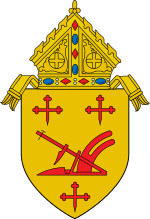William Henry Elder
| William Henry Elder | |
|---|---|
| Bishop of Natchez | |
 | |
| Church | Roman Catholicism |
| See | Diocese of Natchez |
| In office | 1857–1880 |
| Predecessor | James Oliver Van de Velde |
| Successor | Francis Janssens |
| Orders | |
| Ordination | March 29, 1846 |
| Personal details | |
| Born |
March 22, 1819 Baltimore, Maryland |
| Died |
October 31, 1904 Cincinnati, Ohio |
| Previous post |
Diocese of Natchez Bishop of Natchez Diocese of Cincinnati Bishop of Cincinnati Bishop |
William Henry Elder (1819–1904) was a U.S. archbishop. He served as the Roman Catholic Bishop of Natchez from 1857 to 1880 and the Roman Catholic Bishop of Cincinnati between 1883 and 1904.
Biography
Early life and education
William Henry Elder was born in Baltimore, Maryland, on March 22, 1819. His father, Basil Elder, was a descendant of William Elder (1681–1714), a Catholic immigrant from England to Maryland (United States) in colonial times. His mother was Elisabeth Miles (née Snowden) Elder was also Catholic.
In 1831 Elder entered Mt. St. Mary's College, in Emmitsburg, Maryland, then presided over by the Rev. John Baptist Purcell. He afterward became the second bishop, and later the first Archbishop of Cincinnati. Elder graduated in 1837 and entered the seminary. In 1842 he was sent to Urban College in Rome for further studies, where he continued his training for about four more years.
Ordination and Bishop of Natchez
Elder was ordained a priest in Rome, March 29, 1846. He became professor at the seminary at Emmitsburg, Maryland, a position he held until appointed Roman Catholic Bishop of Natchez, for which he was consecrated in the cathedral of Baltimore by Archbishop Francis Kenrick, on May 3, 1857. The diocese was geographically huge, comprising the entire state of Mississippi.
After the Union occupation of Natchez, in 1864 Elder became prominent for refusing to obey the order of the Brigadier General James Madison Tuttle to have prayers for the President of the United States recited publicly in the churches of his diocese. Elder wrote a letter to President Abraham Lincoln regarding the matter. Senator Francis Kernan responded, saying he met with Secretary of War Edwin M. Stanton regarding the matter. Stanton said he would communicate to Tuttle to remedy the situation so there would be not further interference. Elder subsequently wrote thanking Stanton for the protection extended to religious freedom, and asking that the ruling be made known to other commanders so that they also would not interfere with religious freedoms.
Later, Colonel Farrar was placed in command of Natchez; he noted Tuttle's order had neither been rescinded nor was being obeyed. General Mason Brayman, the next commander, took a harder stance, saying "...military orders are to be followed, not discussed..." and issued an order for Elder to be sent to jail in Vidalia, Louisiana. Federal troops took Elder to Vidalia for a few weeks. After Washington officials intervened, Brayman ordered the release of Elder on 12 August 1864.[1]
During his time in Natchez, a yellow fever epidemic broke out in 1878. Ministering to the sick, Elder caught the disease but survived. At the time he arrived in Natchez the diocese had eleven missions (churches), nine priests and 10,000 Catholics. When he left, there were forty-one churches, 25 priests, six religious houses for men, five convents, thirteen parish schools and 12,500 Catholics.
Archbishop of Cincinnati

On January 30, 1880, he was transferred to Cincinnati, becoming auxiliary bishop and coadjutor with the right of succession to Archbishop Purcell, whom he succeeded July 4, 1883. Archbishop Elder was third bishop and second archbishop of Cincinnati. He became bishop at a time of great financial difficulty in the archdiocese. Elder systematically organized the administration of the diocese. He reopened Mount Saint Mary Seminary in 1887, which had been closed since 1879.
He instituted the office of chancellor of the diocese and insisted on annual reports from clergy and parishes in order to bring the diocese out of great debt.
Elder served the archdiocese until his death in Cincinnati on October 31, 1904 from influenza. He is buried at St. Joseph Cemetery, Cincinnati, Ohio.
Legacy and honors
- Elder High School, a Cincinnati parochial school, was named for Bishop Elder.
See also
References
- ↑ Character Glimpses of Most Reverend William Henry Elder, D.D., published by Frederick Pustet & Company, New York and Cincinnati, 1911
External links
| Wikisource has original works written by or about: William Henry Elder |
- Succession of Archbishop William Henry Elder
- Portrait of Archbishop William Henry Elder (Cincinnati Art Museum)
- Biography of William Henry Elder
- St. Mary Basilica Archives, Natchez, Mississippi
- "William Henry Elder". Find a Grave. Retrieved 2009-05-08.
Episcopal succession
| Catholic Church titles | ||
|---|---|---|
| Preceded by James Oliver Van de Velde |
Bishop of Natchez 1857–1880 |
Succeeded by Francis Janssens |
| Preceded by John Baptist Purcell |
Archbishop of Cincinnati 1883–1903 |
Succeeded by Henry K. Moeller |
| ||||||||||||||||||
|
